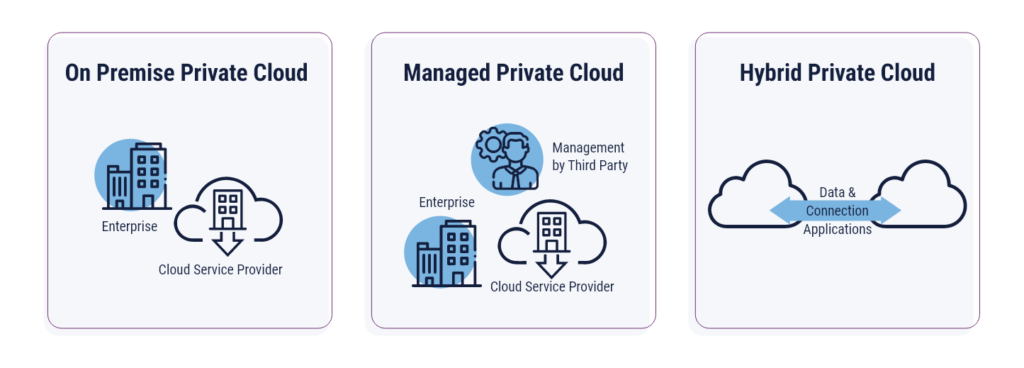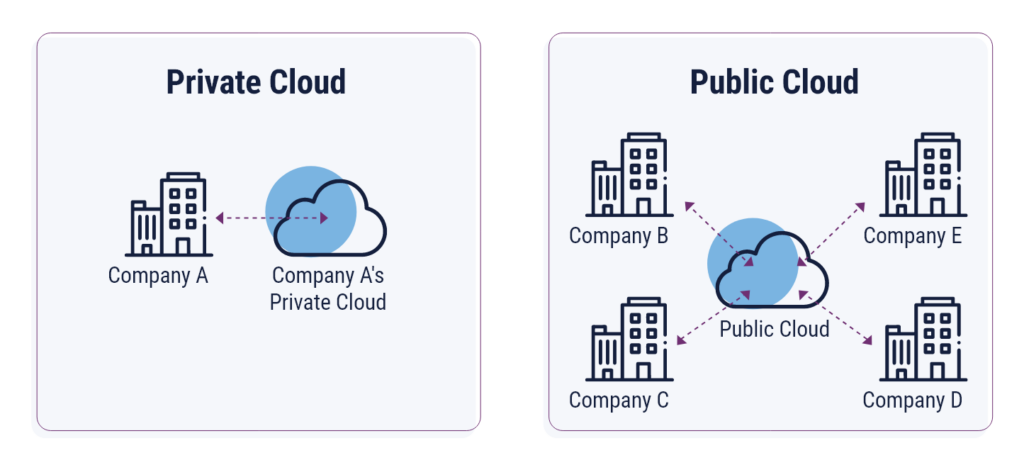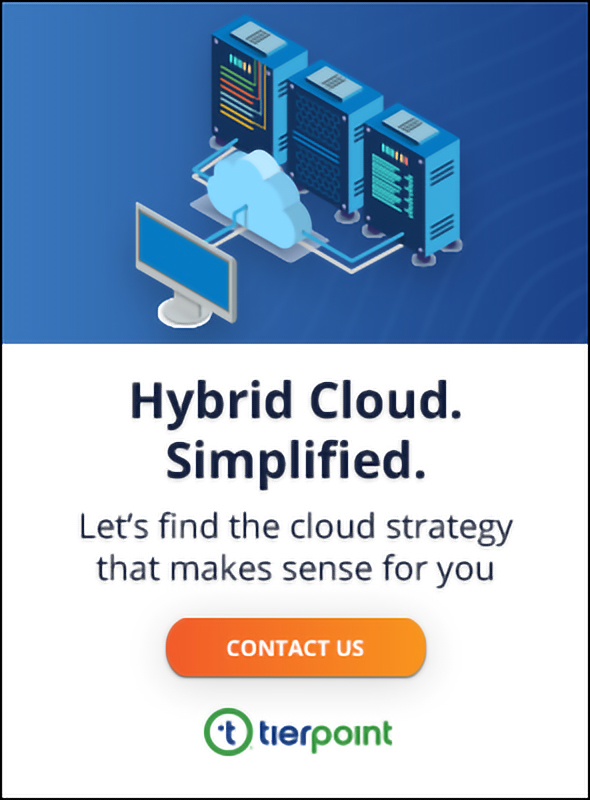
What is Private Cloud Architecture?
Private cloud architecture is a type of cloud computing environment that’s customized and built specifically for the detailed requirements of a particular business. All the resources are dedicated to a single entity or tenant, without sharing resources with others. Data for the business lives in the storage, and the compute can be made up of high-capacity servers, multi-core processors, and large amounts of memory.
Private cloud architecture relies on a resilient network to make use of the high-performance compute and storage. The network facilitates the transfer of data from storage to compute and back, from server to server, and from user to server
Types of Private Cloud Architecture

Private cloud architecture can be categorized into on-premises or fully managed, using either traditional or hyperconverged infrastructure. In addition to on-premises and fully managed private cloud architectures, there is also the hybrid approach that combines both on-premises and cloud-based resources.
On-Premises vs Fully Managed
An on-premises private cloud is managed by the organization itself and hosted in its own data center. A fully managed private cloud is completely handled by a third-party provider. When a business opts to keep some of its workloads on-premises and others in the cloud, they’re taking advantage of a hybrid cloud strategy. The hybrid cloud approach offers greater flexibility in terms of workload deployment and resource utilization.
Traditional or Converged Infrastructure
Traditional (also known as tiered) infrastructure uses separate storage resources, server hardware, and networking to offer better price/performance ratios for private cloud. IT departments that already possess vendor-specified hardware have the option to integrate it within the tiered architecture as a foundation for their solution. This approach can be an attractive option to organizations seeking to leverage their existing capital expenditure (CapEx) hardware investments or to those who need a tailor-made solution to meet their requirements.
Hyperconverged Infrastructure
Hyperconverged infrastructure (HCI) is also an option in private cloud. With it, servers, storage, and networking can all be managed via one system. HCI is generally built using off-the-shelf, commodity hardware and software, making it a more affordable option.
Types of Cloud Service Models
Businesses that use private cloud can also take advantage of infrastructure as a service (IaaS), platform as a service (PaaS), and software as a service (SaaS). IaaS provides cloud IT building blocks. PaaS offers a foundation for application development, testing, deployment, and management. SaaS gives businesses access to applications hosted by third parties.
What is the Difference Between Private Cloud vs. Public Cloud?

While the compute, storage, and network components are fundamentally the same, the biggest difference between public vs private cloud platforms is scale. A private cloud is much smaller than a public cloud. Software architecture is another key difference. A private cloud can run more applications without refactoring or rewriting them. It can also make compliance easier with legacy software licensing terms not written with cloud computing in mind.
Public cloud, on the other hand, has greater potential for cloud scalability, but may also require more work to migrate legacy applications. Most public cloud pricing is based on paying for what you use, which can be more cost-effective for many businesses.
When to Use Private Cloud
Private cloud is usually the best fit for organizations that have specific performance requirements or need a higher level of customization for their workloads. After all, the primary advantage of choosing a private cloud is the environment’s ability to have infrastructure, resources, and services tailored to match the application and data needs of their specific organization.
For example, a business with specialized workloads may choose a private cloud over a public cloud solution due to its level of control and customization. Although public cloud providers can implement robust strategies to protect data, there may be cases in which organizations see a private cloud as a better solution to help them follow strict regulations around sensitive data.
Elements of Private Cloud Architecture
Hardware Infrastructure
The physical equipment used to run the cloud environment are all part of the hardware infrastructure. This includes servers, storage, and networking.
Servers are in charge of running the operating system, storage, and applications. They are the resources at the heart of the private cloud, working as central processing units. Storage operates as the brain, holding all the data for the private cloud. Physical and virtual storage can be used in the infrastructure and networking forms the connection between the servers and the storage.
Workload and Capacity Planning
Private cloud environments handle different workloads. They are identified and prioritized through workload planning, and necessary resources for these prioritized workloads are determined through capacity planning. Cloud management platforms, load balancers, and autoscaling can all be used to assist with planning and workload execution.
Scalability and Resilience
Autoscaling allows resources to scale up or down based on demand. Load balancers can assist with resiliency, distributing traffic across servers and allowing for a backup should the primary system fail. Cloud management tools, in addition to tracking resource usage, can also offer monitoring and alerting systems that promote resiliency.
Virtualization and Hypervisor
An operating system called a hypervisor directs the software in the private cloud and enables multiple virtual machines, each running its own OS, on a single physical device. A hypervisor serves as a gatekeeper over a pool of compute, storage, and network resources for the virtual machines to share. Private clouds contain layers – virtual machines are layered on top of hypervisors, which are built on hardware.
Management Tools or Services
Cloud management tools and services can be applied across the private cloud infrastructure to monitor the environment, alert users to changes, automate certain processes, and provision resources appropriately, among other things.
Benefits of Private Cloud Architecture
The benefits of private cloud architecture can be numerous, including customization, legacy workloads, compliance, and familiarity.
- Customization: Private clouds offer organizations greater control over their infrastructure and data, as they can customize and configure the environment to meet their specific needs. This enables IT teams to tailor their resources and services to match their workload demands, resulting in better performance, efficiency, and cost-effectiveness.
- Legacy workloads: Legacy workloads are often critical to an organization’s operations, and not all legacy workloads and applications will experience the same level of performance or compatability if migrated to a public cloud. Downtime or disruptions can have significant impacts on business continuity. With a private cloud, organizations have complete control over their infrastructure which helps maintain performance, and they can implement their own backup and disaster recovery measures to ensure continuity.
- Compliance: By not sharing software or hardware with other entities, it’s easier for an organization to have a stronger security posture via private cloud and meet compliance mandates.
- Familarity: As the closest cloud technology to what many companies are doing in-house, a private cloud can be an excellent choice for businesses stepping into cloud computing. The internal staff knows the hardware and how it works on a deep level and can decide what goes into the private cloud architecture.
What Are the Risks of Using Private Cloud Architecture?
Despite the benefits, private cloud architecture is not without its risks.
Cloud Waste or Failure
Estimating resource needs for private cloud can be easier said than done. Wasted resources and increased costs can come from overprovisioning – allocating more resources to a workload than is actually necessary. Cloud failure can stem from several causes, such as misconfiguring a cloud resource, software bugs, or hardware failures, leaving a cloud computing service unavailable for use. Increased complexity with private cloud may make you more vulnerable to cloud failure.
Performance Issues
Generally, private cloud offers better performance. However, when provisioning goes in the wrong direction, and you underestimate what you need, performance can take a hit.
Security and Compliance
While private clouds can provide more compliance and tailored security measures for organizations, that doesn’t mean they are immune from security risks. Data breaches, data loss, DDoS attacks, and ransomware can still infiltrate. Monitoring and alerting systems need to be set up to prevent security risks from occurring.
Businesses also need to know what they need to be compliant or work with a provider to ensure measures are taken to ensure compliance in the private cloud environment.
Legacy Applications
Private clouds are well-suited to house legacy applications. However, there may still be a challenge with moving these applications from on-prem architecture to private cloud environments. Legacy application migration is an undertaking in itself and cannot be approached hastily, especially if the application is central to important business processes.
IT Skills Gap
If you choose to operate in a private cloud without a service provider, you may find that members of your IT staff have experience that doesn’t quite align with a private cloud environment. The bigger problem may be having insufficient internal staff to manage a private cloud environment at all, which can be remedied by bringing in third-party help.
The Future of Private Cloud Architecture
As on-prem data centers are fading away, and public cloud providers continue to expand and become more appealing, it may feel like private cloud architecture is destined to fade into the background. However, that isn’t the case as more organizations take a hybrid approach to cloud computing.
A hybrid cloud allows organizations to experience the benefits of both private and public clouds, like the private cloud infrastructure required to meet the needs of specialized workloads and the flexibility of the public cloud. Hybrid cloud architecture also enables organizations to adopt a cloud strategy that is future-proof, allowing them to take advantage of new technologies and trends as they emerge while still maintaining the necessary levels of control and security.
The Importance of Choosing the Right Private Cloud Architecture
For businesses that need full control over their data, applications, and infrastructure, private cloud is the way to go. Whether you’re looking for hybrid, fully managed, traditional/converged infrastructure, or hyperconverged infrastructure, TierPoint can help match you to the right private cloud architecture for you. Learn more about our hosted private cloud services and download our eBook to help determine which cloud is right for your business goals.

FAQs
One of the biggest advantages to private cloud is the level of customization it provides. This can be best for businesses with specific regulatory requirements to meet sensitive data, or legacy workloads that would be difficult to migrate to public cloud.
A virtual private cloud is hosted on a public cloud, offering isolation within a public cloud environment. For example, Amazon Web Services (AWS) offers the Amazon Virtual Private Cloud (AVPC).
With private cloud architecture, a single entity has access to the cloud infrastructure. Examples of providers include VxRail and Nutanix.
Data for private clouds can be stored on-premises at a business’ data center, or offsite at a data center owned by a provider.

